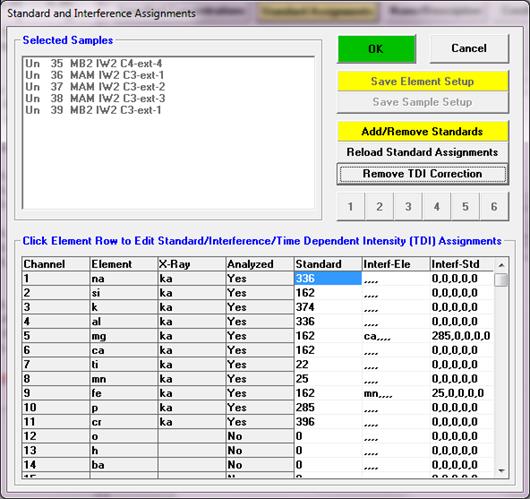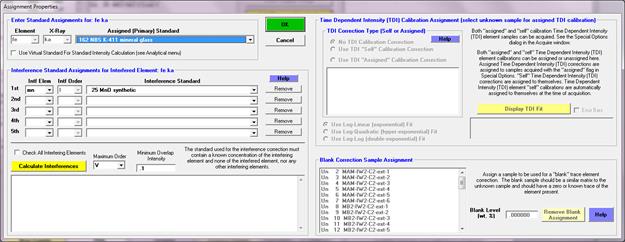Standard Assignments
The standard assignments dialog is used to select the primary standard for the calibration of the quantitative analysis. Each analyzed element must have a standard assigned to it. This dialog is also used to specify the quantitative correction of on-peak interferences and the Time Dependent Intensity (TDI) element correction.

Remember that although the program will automatically load the standard assignments based on the last unknown sample, the standard assignments may be assigned at any time on a sample by sample basis, e.g. for post-processing of data.
The program will load a default set of standard assignments the first time this dialog is opened. These default standard assignments are simply based on the standard containing the highest concentration of each element. It will sometimes be necessary to modify these defaults standard assignments depending on the analytical situation.
Generally when assigning standards for use in the analytical calibration, it is best to use primary standards which contain a major concentration of the element. Standards not assigned but also containing the element are secondary standards and are valuable for checking the quality of the calibration. This can be seen by examining the "%VAR" line in the analysis printout, if they have been acquired as standards, not as unknowns.
Although standards can be reassigned at any later time, the user should be aware that the use of "quick" standards may restrict one's ability to reassign standards off line since the required data may not have been acquired. When running connected to the microprobe (on line) however, you can rerun the affected "quick" standards after changing the standard assignments to obtain the necessary calibration data.

Users may also create subsets of the same elements to acquire on several standards, permitting maximum flexibility. Say you have a sample with feldspars and pyroxenes, and your complete element list holds Na, Mg, Al, Si, K, Ca, Ti, Cr, Mn, and Fe, and you have several silicate standards: albite, microcline, anorthite, wollastonite, enstatite, forsterite, fayalite (as well as others for Ti, Cr and Mn). It would take too long to acquire all elements on all standards, but you don't want to run quick standards either, as you'd like to acquire several elements on multiple standards for maximum flexibility. After peaking all elements and checking pulse height settings, you would save an "all elements" sample setup. Then create a new unknown, feldspar, and delete the Mg, Ti, Cr, and Mn. Save this sample setup as "feldspar". Then create a new unknown, this time recalling the "all elements" sample setup, this time deleting the K and Cr, and saving this as "pyroxene". You could then later "tag" the appropriate standard with the appropriate list of elements, under Automate!.